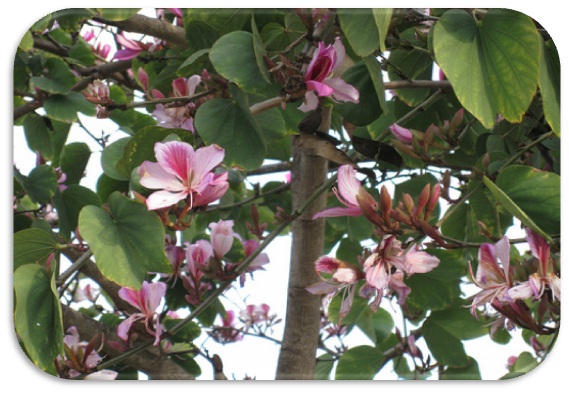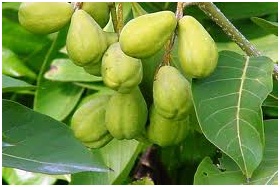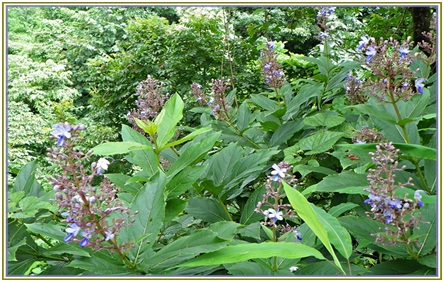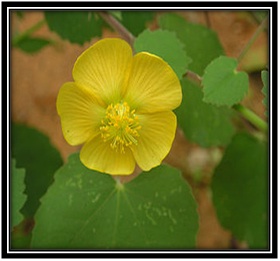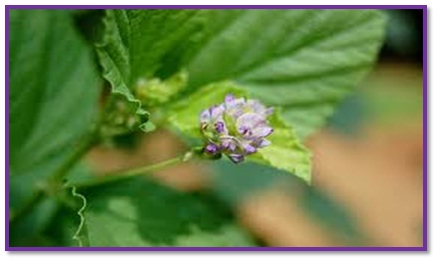Haritaki:- TERMINALIA CHEBULA Retz.
COMBRETACEAE FAMILY
LITERARY REVIEW
TERMINALIA CHEBULA is an extensively used herbal drug
Rtuharitaki
It is classically recommended as rtuharitaki for using the drug during the course of different seasons.
| Rtu
|
Anupana |
| Varsa |
saindhava |
| Sarada |
Sarkara |
| Hemanda |
Sunthi |
| Sisira |
Pippali |
| Vasantha |
Madhu |
| Greeshma |
Guda |
- Various medicinal properties of drug fruit are specified in relation to its mode of use such as chewing,powdering,boiling and frying of fruit is stomachic,laxative, astringent and countering Tri-dosasrespectively.
- Haritaki is having 5 rasas except salt taste.
GANA
According to – Prajasthapana,jwaraghana, kushtaghna , kasahara , arsogna .
According to susrutha -Triphala,amalakyadi,parooshakadi,trivritadigana.
According to susrutha – Triphala,amalakyadi,parooshakadi,trivritadigana.
According to bhavaprakasha –Haritakyadivarga
VERNACULAR NAMES
Sanskrit – pathya,haritaki,abhaya
English – myrobalan,inknut,Indian gallnut
French -Badamierchebule
Germen- Rispigermyrobalanenbaum
Hindi – Har, pile har
Punjabi – Hale la
Arab-halilaja
Persian-halia-hezarda
Sind-imachi
Bengali-hora
Kashmiri-zardhalela
Gujarati-himaja
Telengu-karakkya
Tamil- kadukkai
Malayalam-kadukkai
Kannada-anilaykayi
Sinhala-aralu
Malaya-buahkaduk
Assam-hilikha
Burma-pangah
Chinese- helile
Tulu -anile kayi
SYNOYMS AND INTERPRETATION
Haritaki – one which cures many diseases.
Abhyada – By consuming this drug , there is no fear of disease.
Avyadha – There is no disease .
Padhya – Which is good for the body.
Kayastha- It brings stability.
Pootana – Body becomes pure by its anuloma action.
Haimavathi – Available in himalaya Pradesh.
Chetaki – It opens the channels of body.
Sreyasi – good for health.
Shiva – good for health.
Jaya – to win over the diseases.
Vijaya – To win the diseases it is helpful.
Pranada – Which gives life.
Amritha – Having very good quality like ambrosia.
PROPERTIES
RASA: Pancha rasa yukta,Kashayapradhana , Alana exception
GUNA : Laghu ,Rooksha
Virya : Usna
Vipaka : Madhura
DosaKarma : Tridosahara,Vatasamaka
Prabhava : TridosaSamaka
Karma : rasayana, Vayahsthapana , Ayusya , Sarvarogaprashamana , Deepana, pashana , Anulomana, MrbuRechana, Grahi, krmighna, mehahara, Arsoghna, Hridya, ShonitaSthapana , Prajasthapana, GarbhashayaShothahara, Naditantra, Medhya, VrnaSodhana, VrnaRopana , Jvaragha , Santarpana ,
PRAYOGA
Dosa Karma : Tridusahara
Samstanika Karma : rasayana
NadiSamstana : Naditantra ,Nadidourbalya, Mastiskaclourbalya
PacanaSamstana : AgnimamdyaAjerna, Sulu, Anaba, Adhmama, Vibandha, Chardi , Udararogagulma , krimi, Arsa
RaktaVahaSamstana : Hreldourbalya , RaktaVikaraVatarakta
PrajananSamstana:GarbanaShayadourbalya,Upadamsa
SwasanaSamstana : Kasa ,Swasa, Svaravikara
MootravahaSamstana : Mutrakrcchra , Mutraghata, asmari , prameha .
CHEMICAL CONSTITUTION
- Tannin (30%)
- Chebulinic Acid
- Gallic Acid , resin
- Purgative of Nature of anthrax guinone
- Corilangin
- Chebulagic Acid
TERAPEUTIC USES :
- In Arsas – Haritaki Powder with sugar internally.
- Major drug among rejuvenation.
- Fruit is Stomachic ,tonic , Carminative ,expenturant, antihelmintic , anticlysenteric and alterative .
- In stomach disorders ,powder of Tchebula used internally.
- In pakvaAtisara – Haritaki Powder along with Hot water
- In PanduRoga – Haritaki Powder along with gomuthara
- In vataRakta -Haritaki Powder with guda.
- The ripe fruit is purgative, tonic , carminative and enriches the blood.
- It is useful in ophthamia , diseases of spleen , piles , cold, paralysis . It strengthens brain , eyes , gums .
- Fruits used in sour throat .
- Finely powdered fruit is used as dentrifice medicine useful in carious teeth , bleeding and ulcerative conditions of the gums.
- In condition of constipation, disease with constipation symptometc, fruit powder is taken with warm water in night.
- In sandhivata – Haritakichoorna with castor oil internally .Also in sciatica.
- In bleeding disorders – haritaki powder and pippali powder in equal quantity , given bhavana with swarasa of adathodavascica and given internally along with honey.
FOLK LORE USES
- A decoction of the fruits is a good astringent wash.
- A fruit, coarsely powdered and smoked in pipe, affords relief in a fit of asthma.
- A fine paste, obtained by rubbing the fruit on a rough stone with little water, mixed with oil and applied to burns and scalds.
- The fruit in combination with other drugs is prescribed for snake bite.
RESEARCH STUDIES
- One study reveals the anti oxidant activity of ethanolic extract of terminalicchebula fruit against isoproterenol – induced oxidativestress in rats. the result shows the significant anti oxidant activity.
- Anti – microbial activity ofTerminaliachebula was tested against helicobacter pylori. Waterextracts of terminaliachebula inhibited urease activity of H.pylori signified antibacterial activity.
- chebula exhibited strong anti microbial activity against methiallin resistant strains of staphylococcus aureus.
- chebula extract showed a potent wide spectrum of antibacterial activity against human pathogenic gram positive and negative bacteria.
DOSAGE
Fruit (greater) – 3-6 Gms (as laxative)
Lesser – 1-3 Gms.
FORMULATION
Abhayamodaka , Abhayarishta, Pathyadivadi, Vyaghriharitaki , citrakaharitaki, Agasthyaharitaki, Dantiharitaki, Haritakikhanda , Pathyadichoorna, Haritakyadikwatha, Pathyadikwatha, Dasamoolaharitaki, Triphala, Pathyadivarti, Haritakyadirasayana, Pathyavaleha, Abhayalepa, Pathyatrikam.
ETHNOBOTANY
In India fruits are available in markets. They used as a mild laxative and as an ashriant against wounds and abscesses.
- In dental care dried powder is applied against stomatitis and against ulcers of the gum.
- Plant is used as antidode in snake bites.
- In southeast asia , it is a popular folk medicine for antitussive , homeostatic , laxative and cardiotonic treatments


